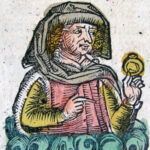The year was 1818. The location was ruins of the Roman Emperor Hadrian’s Villa outside Rome. The wealthy owner of the estate grounds on which the ruins lay had his head groundskeeper engaged in a general cleanup and renovation of the site. Since there was a considerable amount of usable scrap lumber on the estate, the lumber was collected from around the very large complex and sold in a lot to a dealer.
The lumber merchant found, among the scrap, a large wooden crate. From the aged wood and antique iron nails, it appeared to be of very ancient origins. The crate had been found in an underground cellar at the Emperor’s Villa. The crate was carefully opened. Inside was a broken slate tablet with an overlay of dimly visible colors underneath a thick and dust-encrusted varnish. It was difficult to discern the image, but the 16 pieces fit together like a puzzle.
Painters were called in to remove the thick, mottled layers of varnish. Colors with an amazing brilliance and polished finish began to emerge. The astonishing picture slowly revealed a figure of a young, beautiful woman clad in a crimson tunic, with a jeweled golden crown. Matching the crown were a set of earrings, necklace and pendant on her forehead that were inlaid with rubies and emeralds, and the jewelry had fine pearls mounted on the edges. A gold armband with pearls suspended on gold chains and a bracelet of gold were on her right arm.
The jeweled necklace had an intriguing feature- the individual gold segments resembled oval-shaped Egyptian cartouches with hieroglyphics embossed on their surfaces.
But the painting had another, more startling aspect- the young woman had a serpent coiled around her left forearm, and it was in the very act of striking her on the exposed left breast. A pair of puncture marks from a previous strike seeped blood. Her expression was one of profound grief and turmoil. Tears flowed from her sorrowful, upturned eyes. The parted lips revealed the tongue pressed forward between the teeth, as if the serpent’s poison was swiftly taking effect.
The Royal person so vividly portrayed could only be Queen Cleopatra, the last Pharaoh of Egypt, consort of Julius Caesar before his assassination and, in later years, the devoted wife of Mark Antony.
Further examination by experts revealed even more remarkable elements. The painting itself, on a finely-ground surface of gray slate rock was determined to be a supremely crafted example of the lost art of encaustic painting, employed by the ancient Greeks and Romans. The artists of Caesar’s time mixed powdered pigments in into a heated mixture of tree-resin and wax. The hot, mixed encaustic paint was skillfully applied to the slate tablets with a brass spatula. When the painting was completed, the entire surface was melded into a smooth finish by passing red-hot iron bars or braziers full of glowing embers close to the painting’s surface.
The technique of encaustic painting of this type faded into history soon after Caesar’s time and was lost during the Middle Ages. Experiments to revive the lost art began only in the modern era. Furthermore, very few examples exist of this type of encaustic from classical times, even today. For example, over 3,000 Greek sculptures from the classical era have been cataloged, while less than 200 paintings of any type are listed to date.
But where could the clearly ancient painting have come from? Certainly the artist would have been one of the best of his time, and there is a relatively short era of about 250 years during which the process of encaustic painting was developed and refined. It would necessarily been after the time of Cleopatra since it depicted her death by suicide. This leaves a very narrow time period of perhaps 50 years before the technique of encaustic was lost to history.
First let us recall the circumstances of Cleopatra’s death. The Emperor Octavian, Julius Caesar’s nephew, had come with Roman imperial forces to wage war on Marc Antony and Cleopatra, and defeated the Egyptian forces. Marc Antony, returning from battle was told (incorrectly) that Cleopatra had already been killed.
Antony then fell on his sword, to commit suicide. Cleopatra, hearing this, rushed to him, and he died in her arms. Cleopatra, who had lived in Rome with Julius Caesar knew of the Roman custom of displaying their prisoners from vanquished nations in their victory parades. Royal prisoners were marched with chains on their wrists and ankles and led through the streets of Rome. The thought was unbearable to Cleopatra, and she devised a way to commit suicide, tricking the Roman guards that Octavian had charged with watching her.
Although the accounts vary, the story believed by Octavian was that an Egyptian servant brought Cleopatra a basket of figs, inside which a poisonous serpent was hidden. Cleopatra, with her two faithful attendants, arrayed herself in her finest clothes and jewelry, wearing a crown and ornaments of royalty. She then ate some figs, reaching into the basket until bitten by the asp. Her attendants arranged her on her deathbed and then followed her example. Octavian himself is said to have seen the barely perceptible bite marks on her arm and the serpent’s track marks in the sand outside the temple building.
Octavian was furious, having been tricked, and having lost his opportunity to display Cleopatra in chains in his triumphal parade. Later, back in Rome he commissioned an artist, most likely the Greek, Timomachus, to paint a picture of Cleopatra as she commited suicide. (Timomachus had also painted Cleopatra previously when she toured Greece with Marc Antony.) Octavian then displayed the picture on a cart, which was then drawn through the streets in his victory parade. It created a sensation and was viewed by thousands. Later Octavian put the painting on public display in the temple of Saturn in Rome as a votive offering.
Years passed and the painting was handed down from emperor to emperor. One hundred and sixty years later, the Emperor Hadrian had an extravagant, palatial villa built outside of Rome at Tivoli. He furnished it lavishly and decorated it with fabulous works of art. The painting was evidently part of his vast collection. At some point in time, likely years after Hadrian’s death, it was carefully packed in a crate and hidden in a cellar, probably for safekeeping in times of war, invasion or the barbarian pillages that occurred in later years. There it lay, forgotten and hidden for centuries until its re-discovery in 1818.
Several unique elements of the painting attest to it’s authenticity and ancient origins. Cleopatra is depicted, not as an Egyptian of the type we are familiar with from the tombs of the ancient pharaohs of 1500 BC, but as the Macedonian that she actually was. Cleopatra was a direct descendant of Ptolemy I, who was both the boyhood friend of Alexander the Great and a general of Alexander’s forces. He was given charge of Egypt by Alexander and installed himself as the new ruler of Egypt. He was instrumental in the founding of the great city of Alexandria on the delta of the Nile, as the new capital city of Egypt, replacing the ancient capitol of Memphis, which was farther upriver. Thirteen generations of Ptolemies ruled Egypt. Cleopatra VII was the last of her generation, and the last Pharaoh of Egypt.
Cleopatra, in the highly detailed painting is pictured as having dark blond or auburn hair and deep blue eyes. Alexander the Great, who was ethnically Macedonian, (not genetically related to the coastal Greeks that he conquered) was also blond-haired and blue-eyed. Many Macedonians even today still have the genetic characteristics with the prevalence of recessive genes that produce fair skin and light eye coloration. That fact that Cleopatra was not Egyptian, but a descendant of Macedonian royalty, may be difficult for many to accept, but it is nonetheless true. The dynasty founded by Ptolemy was essentially comprised of Macedonian/Greek colonialists. (The names “Cleopatra” and “Ptolemy” are also Macedonian.)
Cleopatra’s hair was depicted including individual strands, and is arranged in elaborate braids sprinkled with gold dust. This is in complete accordance with the marble sculptures of Cleopatra from Caesar’s Rome. (Link to Marble Sculpture of Cleopatra) The hair is obviously very long, and twin braids encircle the neck, ending in a knot into which three rose blossoms, matching her silken tunic, are inserted. The texture of the the hair is shown to be of the type that grows in spiraling coils, also consistent with the Roman sculpture portraits. Interestingly, her eyebrows were also sprinkled with gold dust. (Image link to Cleopatra Bust)
Another very intriguing and significant element is the design of the crown and jewelry that Cleopatra wears. The crown is not Egyptian in character at all, rather it is nearly identical to the Macedonian crowns imprinted on coins minted by Ptolemy V and Ptolemy VIII. (The armband is strikingly similar to one worn by the wife of Heinrich Schliemann, who had excavated it from the ruins of Troy, which he discovered in 1865, years after the painting was found in 1818.)
The only item that has distinctly Egyptian motifs is the necklace, which apparently has golden cartouches embossed with hieroglyphic symbols. A cartouche is an oval shape, inside of which names or titles are inscribed. It is likely that the necklace has the name of Cleopatra and her royal titles (one being Pharaoh of Egypt), inscribed thereon.
The crown and jewelry are inlaid with emeralds and rubies that royal wealth alone could afford. The background of the painting is a shimmering curtain of dark green that, in an artistic touch, echoes the emeralds, as her deep red tunic echoes the color of the rubies. The painting, after its discovery, first passed through the hands of a few owners, at one time even having been pawned. It was later purchased by the Barron de Benneval (French) residing in Sorrento, Italy in 1860, who exhibited it in Paris, London, Munich and Rome. Two engravings after the painting (pictured here) enable us to determine the details as well as concise and written descriptions (listed in the Resources below) by eyewitnesses during the mid 1800s.
Cleopatra is shown to be quite beautiful, as the ancient Roman and Greek sources of Dio Cassius, and Appian have attested. (Recently there have been statements based on the image of Cleopatra on coins that are contradictory to this. It is more likely, however, that the coins were simply clumsily re-worked images of her father, Ptolemy XII.) The Greek and Roman busts of Cleopatra show a woman with symmetrical features and smooth skin. There is a moderate bridge to the nose and slightly flared nostrils, but nothing that would be considered out of proportion or the least bit unsightly. In fact, Marc Antony fell in love with her at first sight, and Julius Caesar also had a long love affair with her. Both men were among the most powerful and influential of their time, and both risked public censure to continue in their relationships with her. Cleopatra ,who could speak nine languages, had an appealing, musical tone to her voice and was charming in conversation as well as being very persuasive. Cleopatra was actually the first Ptolemaic Pharaoh who actually learned to speak Egyptian.
At present the whereabouts of the painting appear to be unknown to the general public. Its last recorded location was with the Barron de Benneval in Sorrento. It is likely that in the chaos of wars in the early 20th century, the painting was either hidden for safekeeping, lost in bombing raids or pillaged by invaders. If it is ever relocated, it would be one of the world’s greatest art treasures and an object of significant scientific and historical interest. If proven authentic it could help resolve the question of: “What did Cleopatra really look like?”
Resources:
Online Images:
(1) https://oncourse.iu.edu/access/content/user/leach/www/2003/cleopatra.jpg
(2) http://www.dl.ket.org/latin1/gallery/people/images/cleopatra_.jpg
Print Media:
Illustrations:
“Cleopatra -engraving in steel after the Encaustic Painting of Sorrento” . John Sartain (c.1880) illustration for “On the Antique Painting in Encaustic or Cleopatra discovered in 1818” by John Sartain, Cosimo Ridolfi & Reinhold Shoener
“Cleopatra” John Shury (c.1826) engraving in “The Saturday Magazine” Vol. V, London 1841
Books and Articles:
“On the Antique Painting in Encaustic of Cleopatra Discovered in 1818” by John Sartain, Cosimo Ridolfi & Reinhold Shoener
{Publisher: George Gebbie & Co. Philadelphia 1885}
“London Magazine” May 1 1826. Article by John Scott, John Taylor . Illustration by John Shury
The New York Times”, August 21, 1881
“The Saturday Magazine” Vol. V London 1841
“Dictionary of Greek and Roman Antiquities” edited William Smith (1870).
“Plutarch’s Parallel Lives” (1916) translated by B. Perrin
Dio Cassius: Roman History” (1916) translated by Earnest Cary and Herbert B. Foster (Loeb Classical Library)
Appian: The Civil Wars” (1996) translated by John Carter (Penguin Classics)





